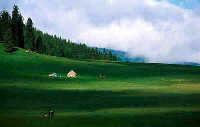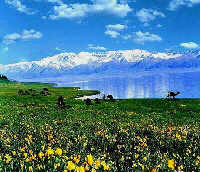| |
Bortala Prefecture
( 2005-09-13 )
 The Bortala Mongolian Autonomous Prefecture is located on the northern slope of the western chain of the Tianshan Mountains and the western edge of the Junggar Basin. Bole city -- the location of the prefecture government -- is 524 kilometers away from Urumqi (capital of Northwest China'sXinjiangUygur Autonomous Region) based on highway distance. The northern Xinjiang railway runs across the southeast part of the prefecture, with a total length of 140 kilometers. The Bortala Mongolian Autonomous Prefecture is located on the northern slope of the western chain of the Tianshan Mountains and the western edge of the Junggar Basin. Bole city -- the location of the prefecture government -- is 524 kilometers away from Urumqi (capital of Northwest China'sXinjiangUygur Autonomous Region) based on highway distance. The northern Xinjiang railway runs across the southeast part of the prefecture, with a total length of 140 kilometers.
Under the prefecture's administration are two counties and one city, with a total population of 415,800 (including the population at the border under China's military division five -- the Xinjiang production and construction corps), of which ethnic minorities are 137,900.
The area, located in the northern temperate zone, has a continental arid climate. It also has a cultivated land area of 71,500 hectares, a sown grain area of 22,400 hectares, and a cash crop-sown area of 45,700 hectares.
Bortala ("green grassland" in the Mongolian language) was once an important passage on the north path of the ancientSilk Road. It was reputed as the "heavenly land beyond the noisy world." Today, Bortala has become one of the important gateways to Northwest China -- it is the west fort (China part) of the New Asian-Europe Continental Bridge, boasting Alashankou Port, the second-largest continental port in China.
Its famous native and special produces include wolfberry, melon seeds, Fritillaria thunbergli (a herb), Saussurea involucrate (a herb), and aromatic tobacco.
 The total volume of the area's surface and ground water is 24.34 hundred million 11.43 hundred million cubic meters respectively. The total volume of the area's surface and ground water is 24.34 hundred million 11.43 hundred million cubic meters respectively.
The total area of natural forest is 208,800 hectares, the preserved area of man-made forest, 19,900 hectares, and mountainous forest reserve, 8,990,000 cubic meters. The main species of trees are the Tianshan spruce, the snow spruce, the Tianshan birch, and the pinus sylvestris variety. It has a superior natural pastureland of 1.62 million hectares.
The rare wild animals are sable,snow leopard, north goat, red deer, argali, falcon, gray crane, North Xinjiang salamander, and red fox. The prefecture has three nature reserves at provincial level, with an area of 30,700 hectares.
The medicinal plants are mainly licorice, Ephedra sinica, sea-buckthorn, Cistanche salsa, Cynomorium songaricum, wolfberry, Lop hemp, and Bole Fritillaria thunbergli. The mineral resources are mainly salt, phosphorus, perlite, marble, granite, limestone, tungsten, gypsum, copper, lead, and zinc.
The tourist attractions are the Sayrim Lake, the Habtuha Oddly Shaped Rock Valley, the Hariturege Scenic Spot, the Turki Stone-Man Tombs, and the Miriqige Grassland.
|
|

